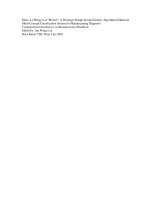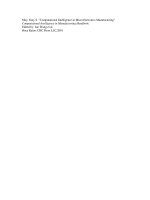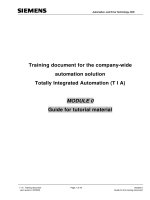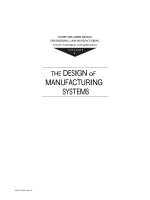Miscellaneous Organic Chemical Manufacturing MACT Training doc
Bạn đang xem bản rút gọn của tài liệu. Xem và tải ngay bản đầy đủ của tài liệu tại đây (1.27 MB, 113 trang )
EPA Course Number AIR 206
Miscellaneous Organic
Chemical Manufacturing
MACT Training
[This page intentionally left blank.]
Miscellaneous Organic Chemical
Manufacturing MACT Training
EPA Contract No. 3W-2360-NALX
Prepared for:
Marcia Mia
Office of Enforcement and Compliance Assurance
U.S. Environmental Protection Agency
Washington, DC 20460
Prepared by:
RTI International
3040 Cornwallis Road
Research Triangle Park, North Carolina 27709
April 2004
[This page intentionally left blank.]
ii
Miscellaneous Organic Chemical
Manufacturing MACT Training
Table of Contents
Title Presentation #
Overview of Industry 1
Overview of NESHAP
2
Applicability 3
Emission Standards
4
Case Study 5
Initial Compliance Requirements
6
Ongoing Compliance Requirements 7
Recordkeeping and Reporting
8
Alternative Standard 9
Pollution Prevention
10
Comparison of Rule Requirements for PAI, PHARMA, and MON 11
Review of Available Implementation Tools
12
Other Questions and Answers 13
iii
Miscellaneous Organic Chemical
Manufacturing MACT Training
List of Appendices
Appendix A
Compliance Timeline
Appendix B
Tabular Summaries of Requirements in Subpart FFFF and
Comparisons of Requirements in Subparts GGG, MMM, and
FFFF
Appendix C Applicability and Compliance Flowcharts
Appendix D
Case Study Data
Appendix E
Equations and Exercises to Calculate Uncontrolled Process
Vent Emissions
Appendix F
Exercise to Determine Ongoing Compliance Status
Appendix G Acronyms, Definitions, and Applicability Materials
Appendix H
Presenter’s Biographical Sketches
iv
1
Chemical Manufacturing
MACT Training
EPA Course Number AIR 206
Miscellaneous Organic
Miscellaneous Organic Chemical
Manufacturing MACT Training
Overview of Industry
Overview of NESHAP
Applicability
Emission Standards
Case Study
Initial Compliance Requirements
Ongoing Compliance Requirements
Recordkeeping and Reporting
Alternative Standard
Pollution Prevention
Practical Aspects of Inspection
Comparison of Rule Requirements for PAI, PHARMA, and MON
Review of Available Implementation Tools
Other Questions and Answers
1
2
[This page intentionally left blank.]
2
3
1.0 Overview of the Industry
l
National Emission Standards for Miscellaneous
Organic Chemica Manufacturing
4
Overview of the Industry
Background
Discussion of Source Category List and
Section 112 of the Clean Air Act
Subsumed Categories
Data Collection and Rule Development
1.0 Overview of the Industry
3
5
Section 112
Section 112 of the Clean Air Act
Amendments of 1990
112 (b) List of HAP
MACT Floor
112 (c) Source Category List
112 (d) MACT
Best 12% of sources (existing)
Best of best (new)
1.0 Overview of the Industry
6
Source Categories
Source Categories
www.epa.gov/ttn/atw/socatlst/socatpg.html
Feb 12, 2002 (67 FR 6521)
Specialty organic chemicals
Explosives
Certain polymers and resins
Latest list for major sources:
Pesticide intermediates
Implications for 112 (j)
1.0 Overview of the Industry
4
7
Types of Processes
Feed
Preparation
Reaction
Formulation
Drying
Solvent
Recovery
Product
Storage
Chemical Manufacturing
1.0 Overview of the Industry
8
Types of Processes
Polymer Manufacturing
1.0 Overview of the Industry
Degasser
Ethylene
Butene
Hydrogen
Compressor
Air
To silo
and
product
bagging
Ethylene
and
Hydrogen
Catalyst
Preparation
Powder
Withdrawal
Gas recycle
Additives
Treater
Cyclone
Fluid
Bed
Reactor
Reactor
Extruder/
Pelletizer
5
9
Processing Scale
Small scale, batch
manufacturers to
SOCMI facilities
1.0 Overview of the Industry
10
Non-Dedicated Equipment
DCB6
C5
CA4
CBA3
A2
A1
Bay
li li
123456
Areas
Process
Production Activities at Factory A
Reactors
Process Tanks
Filters
Evaporators
Crysta zers
Reactors
Process Tanks
Filters
Evaporators
Crysta zers
Reactors
Process Tanks
Filters
Evaporators
Crystalizers
Reactors
Process Tanks
Filters
Evaporators
Crystalizers
Reactors
Process Tanks
Filters
Evaporators
Crystalizers
Reactors
Process Tanks
Filters
Evaporators
Crystalizers
Equipment
Production
1.0 Overview of the Industry
6
1
2.0 Overview of NESHAP
(40 CFR part 63,
subpart FFFF)
l
National Emission Standards for Miscellaneous
Organic Chemica Manufacturing
Overview of Subpart FFFF
Development history
Summary of requirements
Key changes since proposal
Impacts
Compliance timeline
2.0 Overview of NESHAP
7
2
3
Development History
Project started in 1995
Data collection in 1997
Proposal: April 4, 2002
Promulgation: November 10, 2003
Litigation…?
2.0 Overview of NESHAP
Organization of Subpart FFFF
What’s covered (applicability)
Compliance dates
Standards and compliance requirements
Alternative means of compliance
Notifications, Reports, and Records
Other Requirements
2.0 Overview of NESHAP
8
4
5
Overview of Applicability
emissions
Process units that:
Several cited exclusions
Facility must be a major source of HAP
Produce organic chemicals that are not subject to
other MACT standards
Process, use, or produce organic HAP or
hydrogen halide and halogen HAP
Batch process vents from HON process units
2.0 Overview of NESHAP
Overview of Standards
Standards for:
Process vents
Storage tanks
Transfer operations
Wastewater
Equipment leaks
Heat exchange systems
2.0 Overview of NESHAP
9
6
7
Overview of Compliance
Requirements
Most compliance requirements are specified
by cross-referencing other rules
Emission Point/Equipment Referenced Subparts
Continuous process vents G and SS
Batch process vents SS and GGG
Storage tanks WW and SS and GGG
Equipment leaks TT and UU
Process wastewater G
Maintenance wastewater and F
heat exchange systems
Transfer operations SS
2.0 Overview of NESHAP
Initial Compliance Overview
Determine Group status, or designate as
Group 1
Group 1 emissions vented to APCD
Performance test, design evaluation, or calculate
controlled emissions
Establish operating limits for parameter monitoring
Wastewater treatment units
Performance test or design evaluation
Initial inspections
Floating roofs, closed-vent systems, waste
management units
2.0 Overview of NESHAP
10
8
9
Ongoing Compliance Overview
Vent streams to APCD or recovery device
Monitor parameters (generally continuously)
Average parameter readings (generally daily)
Wastewater treatment unit parameter
monitoring
M21 monitoring and visual inspections for
equipment leaks (LDAR program)
Periodic inspections
Floating roofs, closed-vent systems, waste
management units
2.0 Overview of NESHAP
Recordkeeping Overview
Operating scenarios for each process
Various written plans
Startup, shutdown, and malfunction plan
Maintenance wastewater plan
Plans for inspecting unsafe- or difficult-to-inspect equipment
Ongoing records. For example,
Monitoring data and documentation of periods when
operating limits are exceeded
Inspection results and documentation of repairs
Operating log or schedule
Documentation of SSM events
2.0 Overview of NESHAP
11
10
11
Reporting Overview
Initial notification
Precompliance report
Notification of compliance status
Compliance reports
Miscellaneous reports required by the General
Provisions
Notification of performance test (and test plan)
Notification of CEMS performance evaluation
Request for extension of compliance
Application for approval of construction or reconstruction
2.0 Overview of NESHAP
12
Exceptions to General Provisions
Startup, shutdown, and malfunction
Records (occurrence, duration, and actions) and
reports required only if excess emissions occur
No immediate SSM report
2.0 Overview of NESHAP
(continued)
12
13
Exceptions to General Provisions
Performance tests
Must conduct no later than 150 days after
compliance date
vents
representative conditions
Site-specific test plan must be submitted with
notification of performance test for batch process
Performance tests for batch process vents must be
conducted under worst-case conditions rather than
2.0 Overview of NESHAP
(continued)
Exceptions to General Provisions
Compliance reports
Changes to information already submitted in NOCS are to be
reported in compliance reports rather than within 15 days of
the change
Required semiannually; the provisions that specify more
frequent reporting do not apply
Only one type of report (i.e., not summary reports and excess
emissions reports)
Information to report doesn’t depend on percentage of time
during which excess emissions occur
Certain CPMS records are excluded
2.0 Overview of NESHAP
13
14
15
Differences From Subpart SS
Initial compliance
Must conduct performance tests for batch process vents
under worst-case conditions, not maximum
representative conditions
Design evaluation instead of performance test is allowed
for small control devices
Correct concentrations to 3% oxygen for supplemental
gases rather than supplemental combustion air
May elect to conduct design evaluation for halogen
scrubbers regardless of scrubber size
Determine controlled emissions for condensers using
procedure in subpart GGG rather than conducting
performance test or design evaluation
(continued)
2.0 Overview of NESHAP
Differences From Subpart SS
Ongoing compliance
Measure caustic strength as alternative to pH
Alternative monitoring for catalytic incinerators
Operating limits for batch operations may be averaged
over the batch operations rather than daily
For batch process vent control devices, alternative to
continuous monitoring is allowed if inlet HAP is <1 tpy
Monitoring data collected during periods of SSM are to
be used in calculating daily averages
Excused excursions are not allowed
(continued)
2.0 Overview of NESHAP
14
16
17
Differences From Subpart SS
Other
flow may not be used in averages
devices, foll
i ing plan
Install a flow indicator at inlet or outlet of
control device if flow could cease periodically;
Monitoring data collected during periods of no
For storage tank emissions vented to control
ow the same provisions as for
process vents, not the mon tor
approach in §63.985(c)
2.0 Overview of NESHAP
Key Changes Since Proposal
Significant changes to format
Developed separate thresholds for control of partially soluble
and soluble HAP in wastewater
Added emission limits for hydrogen halide and halogen
emissions from process vents
Added less-stringent LDAR requirements for processes with
batch process vents
Deleted calibration and other QA/QC specifications in favor of
the requirements in subpart SS
Eliminated the immediate SSM reporting requirement
Added “process unit group” compliance option for non-
dedicated equipment
2.0 Overview of NESHAP
15
18
19
Process Unit Group
Process Vessels Process A Process B Process C Process D
R400 decanter
batch still
R410 reactor
extraction hold tank
R420 decant/wash
reactor
R270 reactor
reactor
R250
hold tank
extraction
R160
hold tank
chlorinator
R150
batch still
batch still
R130
receiver
receiver
R390
reactor
extractor
R280
extraction
hold tank pH adjust
R2400
separator hold tank
T2300
hold tank
hold tank
T1300
hold tank
receiver
2.0 Overview of NESHAP
20
Process Unit Group
Create PUG
Process units with overlapping
equipment
Projection of processes to be run in
May add process units in the future if
5-year period
there is overlap
(continued)
2.0 Overview of NESHAP
16
21
Process Unit Group
Determine primary product
Type of material projected to be made
for the greatest operating time in the
Redetermine at least every 5 years
5-year period
(continued)
2.0 Overview of NESHAP
22
Process Unit Group
Generally, comply with the rule that
applies to the primary product for all
process units in the PUG
2.0 Overview of NESHAP
17
Initial
Notification
(§63.2515(b))
Compliance
Date
(§63.2445)
Initial
Notification
of Compliance
Status (NOCS)
(§63.2520(d))
Precompliance
Report
(§63.2520(c))
Compliance
Reports
(§63.2520(e))
Site-Specific
Test Plan
and
Notification of
Planned
Performance
Test
(§63.2515(c))
23
Impacts
Approximately 260 facilities with emission
points that meet some of the thresholds for
control
Estimated HAP reductions: 16,800 tpy
Estimated cost: $75 million/yr
2.0 Overview of NESHAP
24
Effective date
November 10,
2003
New sources
initial startup
after
April 4, 2002
(Rule
proposal
date)
March 9,
2004
March 9,
2004 or
120 days
after
initial
startup,
whichever
is later
November 10,
2006
November 10,
2003 or
upon initial
startup,
whichever
is later
April 7,
2007
150 days
after
the
Compliance
date
May 6,
2006
With the
application
for approval
of
construction
or
reconstruction
August 31,
2007
and
every 6
months
thereafter
First Aug 31or Feb 28
following the end
of the compliance
period that occurs
more than 6 months
after the compliance
date, and every
6 months thereafter
60 days
before
performance
test
60 days
before
performance
test
New sources
initial startup
after
April 4, 2002
(Rule
proposal
date)
March 9,
2004
March 9,
2004 or
120 days
after
initial
startup,
whichever
is later
Initial
Notification
(§63.2515(b))
November 10,
2006
November 10,
2003 or
upon initial
startup,
whichever
is later
Compliance
Date
(§63.2445)
April 7,
2007
150 days
after
the
Compliance
date
Notification
of Compliance
Status (NOCS)
(§63.2520(d))
May 6,
2006
With the
application
for approval
of
construction
or
reconstruction
Precompliance
Report
(§63.2520(c))
August 31,
2007
and
every 6
months
thereafter
Compliance
Reports
(§63.2520(e))
First Aug 31or Feb 28
following the end
of the compliance
period that occurs
more than 6 months
after the compliance
date, and every
6 months thereafter
60 days
before
performance
test
60 days
before
performance
test
Site-Specific
Test Plan
and
Notification of
Planned
Performance
Test
(§63.2515(c))
Compliance Timeline
2.0 Overview of NESHAP
Existing
sources –
initial startup
before April 4,
2002 (Rule
proposal date)
18
1
3.0 Applicability
l
National Emission Standards for Miscellaneous
Organic Chemica Manufacturing
2
Applicability Topics
Definitions
Types and Functions of Affected
Units
Questions and Answers
Affected Source
3.0 Applicability
19









